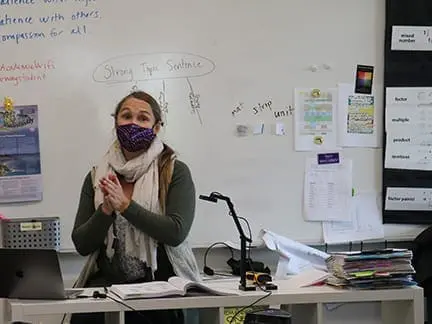Seven ways to build a child’s resilience during the pandemic …and long after it ends
by Phyllis Fagell
“When Nick von Hindenburg, 12, moved from the Netherlands to the District at the start of seventh grade, the pandemic and online school limited his opportunities to make friends. But after moving seven times and living on three continents, he had the skills to adapt. “I’ve never been in this exact situation before, but I’ve had to adjust to different cultures, traditions and ways of teaching,” Nick said. He understands that life is more like a jungle gym than a ladder, said his mother, Anisha Abraham, a pediatrician at Children’s National Hospital and author of “Raising Global Teens: A Practical Handbook for Parenting in the 21st Century.” “Challenge and change have made him stronger.”
For many children across the United States, the pandemic is the first time they’ve had to deal with a disruption of this scale, and some are faring better than others. As a school counselor, I know that parents of struggling kids feel powerless and worry about long-term emotional fallout. Although caregivers can’t always alter children’s circumstances or shield them from discomfort, they can offer a more enduring gift: tools to manage adversity.
“Resilience works like a muscle we can build through effort and repetition, and we want to keep our muscles strong and flexible, so we can think of many ways to solve a problem,” says Mary Alvord, co-author of “Resilience Builder Program for Children and Adolescents.” “At the core, resilience is the belief that while you can’t control everything in your life, there are many aspects you can control, including your attitude.”
Here are seven ways adults can help children cope with adversity and retain a hopeful outlook during the pandemic — and long after it ends. A pandemic winter feels daunting. Here’s how parents can help kids cope.
Leverage their interests
Fan the flames on children’s passions to give them a sense of purpose, a distraction from distress and a way to connect with like-minded peers. Nick has discovered, for example, that building and painting stave off boredom during coronavirus shutdowns. He made his holiday gifts this year, and he recently designed a lemonade dispenser out of cardboard and tinfoil. When Abraham’s son Kai, 10, had a hard time adjusting to online learning and yearned to spend more time with friends, she signed him up for an outdoor book club with other fourth- and fifth-grade boys who enjoy reading. “I got to know kids on my street and share something I love,” Kai said. The boys like to discuss books that feature characters navigating similarly difficult situations, such as “Hatchet”and “Hoot.” Kai also adores animals, so he started walking a neighbor’s dog — the highlight of his day.
Focus on pacing, recovery
As the pandemic drags on, now with less daylight, many children (and their caregivers) are running on empty. Endurance athletes have to dig deep when their reserves are low, so I asked professional ski mountaineer Caroline Gleich how she sustains her stamina. “I constantly check in with myself,” she says. “When I summited Everest in 2019, I had to be super honest and ask: ‘Am I thinking clearly? Is summit fever clouding my decision-making? Are my fingers okay? Do I have enough energy?’ ”
Help children assess what will refuel their tanks.
Do they need time to escape into a novel? A reminder that this won’t last forever? A break from social media? A mental health day? Help setting realistic goals or asserting their needs? Some children may simply need reassurance that they’re up to the challenge. “When I climbed Cho Oyu — the sixth-highest peak in the world — I got very sick with pulmonary edema and had to go back,” Gleich recalls. “I told my physician I was depleted and terrified. She said, ‘Caroline, we’re capable of so much more than we know,’ and that’s become a mantra for me when I’m super drained.” Acknowledge small victories, even if it’s just getting off the couch or making it through another day of online school. “I’ve learned from injuries and setbacks to find places to celebrate,” Gleich says, “like running my first 5K after ACL reconstructive surgery, even though I’d run marathons before.” At the same time, recognize that no child (or adult) can always hold it together. Give your child the space and permission to, at times, fall apart.
How to tame your temper when pandemic parenting stress has you boiling.
Teach problem-solving skills
Draw on children’s interests to help them solve problems. Ryan C.T. DeLapp, a psychologist with the Montefiore Health System in New York, challenges his Lego-loving clients to build a structure without talking. “We have to think of an alternative strategy, such as using a whiteboard, gesturing or writing down our instructions,” he says. He uses the STEPS approach, asking kids to state the problem, think of multiple solutions, explore the pros and cons of each option, and pick a solution and backup solution. Help children anticipate stressful situations and how they might respond, whether it’s getting cut from a team or rejected from a college. “When I worked with kindergarten and first-grade students,” DeLapp says, “I would use the analogy of going to the ice cream store and ask, ‘What if they’re out of your favorite ice cream? What are options B and C, and what are the pros of those, even if option A isn’t available?’ ” When kids use problem-solving skills, praise them for being flexible, despite disappointment.
Set brave goals––
“A huge element of resilience is being able to identify a goal for yourself, to be able to tolerate the discomfort that’s creating resistance toward that goal and — once you meet that goal — being able to celebrate it,” DeLapp says. Individualize kids’ brave goals. If children are struggling to show their face on camera, you might ask: “Is not being on camera interfering with your academics or likely to make it harder for you to be visual socially when the pandemic ends?” If they feel awkward being on camera but value confidence and having positive self-worth, then keeping the camera off could be impeding their goals, DeLapp says. “That represents an opportunity for a brave goal.” Make time to reflect on progress toward their brave goals, and express gratitude and excitement when they meet them.
Identify what they can control
“We can’t completely control the restrictions placed on us to keep us safe during the pandemic, or missing out on playdates and school activities, or economic hardships of the family,” but children are not helpless, Alvord says. Start a dialogue about what children think they can and can’t control, she says. “Can they control their reaction if a friend says something negative? Can they make choices about what they do during their free time?” Then convey that they have options and can be proactive. Alvord suggests saying: “ ‘What is going well? What is not going well? If something is not going well, what thoughts, statements or actions might be helpful?’ ” She recommends solving problems out loud to model for children that there is more than one way to handle something.
Label difficult emotions
Many children have lost their go-to coping strategies during the pandemic, such as playing sports or seeing friends, says social worker Amy Morin, editor in chief of Verywell Mind, an online resource for mental health. “Saying, ‘You seem frustrated,’ or, ‘You look sad,’ can take the sting out of emotions” and help them get to the problem-solving stage, she says. Encourage children to experiment with coping strategies, such as painting, writing in a journal, deep breathing, taking a walk or calling a friend. Afterward, have them rank their mood on a scale of one to 10. “If it’s a four, say, ‘What can we do to get you to a six?’ ” Morin says. Label your own emotions, too, and tell your child how you’re going to manage them. “You don’t want to burden them with adult emotions, but they’re going to pick up on your distress whether you mention it or not,” Morin says. “If you say, ‘I’m stressed about an issue at work, so I’m going to take a walk,’ then the kid knows, ‘Okay, mom is stressed, but she’s taking care of herself, so it’s going to be okay.’ ”
How parents can protect kids’ mental health during the pandemic
Impart ‘the power of and’
Validate that the past year has involved hardship and frustration, and help your child identify any skills or insights gained because of the pandemic. “This isn’t just positive thinking. It’s ‘the power of and’ — acknowledging that two things can be true at the same time,” DeLapp says. “If we’re too positive, it can become an empty platitude. The ‘and’ addresses our natural instinct to dichotomize an experience and call it either good or bad.” The pandemic has interrupted normalcy, but it has also “stripped away certain things that we’ve relied on pretty heavily, and that aren’t all that necessary,” DeLapp says. For example, many teens have realized that they’ve been defining themselves by their academics. “Their whole schedule was geared toward getting the right resume, and covid created an opportunity to take a step back, reevaluate what’s important and recover from that pace.” To demonstrate that there’s more to an experience than the pain we’re experiencing, DeLapp will show a child a photograph, then zoom in on a specific detail. “I’ll ask, ‘If we only focus on this one part, does that mean the rest of it doesn’t exist?’ ” Even as you help children to live in a more realistic place with shades of gray, encourage them to hang on to moments of joy. As Morin says: “We talk about resilience as bouncing back from hard times, but mental strength also is about living your best life when life is going well.””
Phyllis L. Fagell, a licensed clinical professional counselor, is the author of “Middle School Matters,” the school counselor at Sheridan School and a therapist at the Chrysalis Group. She tweets @pfagell and blogs at phyllisfagell.com . This article appeared in TheWashington Post, January 26, 2021.





